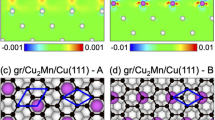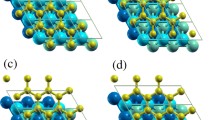Abstract
A study is reported of the role played by covalent interaction in the coupling of graphene formed on Ni(111) to the Ni substrate and after intercalation of Au and Cu monolayers underneath the graphene. Covalent interaction of the graphene π states with d states of the underlying metal (Ni, Au, Cu) has been shown to bring about noticeable distortion of the dispersion relations of the graphene electronic π states in the region of crossing with d states, which can be described in terms of avoided-crossing effects and formation of bonding and antibonding d-π states. The overall graphene coupling to a substrate is mediated by the energy and occupation of the hybridized states involved. Because graphene formed directly on the Ni(111) surface has only bonding-type occupied states, the coupling to the substrate is very strong. Interaction with intercalated Au and Cu layers makes occupation of states of the antibonding and bonding types comparable, which translates into a weak resultant overall coupling of graphene to the substrate. As a result, after intercalation of Au atoms, the electronic structure becomes similar to that of quasi-free-standing graphene, with linear dispersion of π states at the K point of the Brillouin zone and the Dirac point localized close to the Fermi level. Intercalation of Cu atoms under the graphene monolayer results, besides generation of covalent interaction, in a slight charge transport, with a partial occupation of the previously unoccupied π* states and the Dirac point shifted by 0.35 eV toward increasing binding energy.
Similar content being viewed by others
References
A. K. Geim and K. S. Novoselov, Nat. Mater. 6, 183 (2007).
K. S. Novoselov, A. K. Geim, S. V. Morozov, D. Jiang, M. I. Katsnelson, I. V. Grigorieva, S. V. Dubonos, and A. A. Firsov, Nature (London) 438, 197 (2005).
C. W. Banakker, Rev. Mod. Phys. 80, 1337 (2008).
M. I. Katsnelson, K. S. Novoselov, and A. K. Geim, Nat. Phys. 2, 620 (2006).
A. Bostwick, T. Ohta, Th. Seyler, K. Horn, and E. Rotenberg, Nat. Phys. 3, 36 (2007).
A. Bostwick, T. Ohta, J. McChesney, K. V. Emtsev, Th. Seyler, K. Horn, and E. Rotenberg, New J. Phys. 9, 385 (2007).
A. M. Shikin, D. Farias, and K. H. Rieder, Europhys. Lett. 44, 44 (1998).
A. M. Shikin, D. Farias, V. K. Adamchuk, and K. H. Rieder, Surf. Sci. 424, 155 (1999).
A. M. Shikin, G. V. Prudnikova, V. K. Adamchuk, W.-H. Soe, K.-H. Rieder, S. L. Molodtsov, and C. Laubschat, Phys. Solid State 44(4), 677 (2002).
D. Farías, K. H. Rieder, A. M. Shikin, V. K. Adamchuk, T. Tanaka, and C. Oshima, Surf. Sci. 454–456, 437 (2000).
A. Varykhalov, J. Sanchez-Barriga, A. M. Shikin, C. Bismas, E. Veskovo, A. Rybkin, D. Marchenko, and O. Rader, Phys. Rev. Lett. 101, 157601 (2008).
A. M. Shikin, V. K. Adamchuk, and K.-H. Rieder, Phys. Solid State 51(11), 2390 (2009).
Yu. S. Dedkov, A. M. Shikin, V. K. Adamchuk, S. L. Molodtsov, C. Laubschat, A. Bauer, and G. Kaindl, Phys. Rev. B: Condens. Matter 64, 045503 (2001).
A. M. Shikin, G. V. Prudnikova, V. K. Adamchuk, F. Moresco, and K.-H. Rieder, Phys. Rev. B: Condens. Matter 62, 13202 (2000).
A. G. Starodubov, M. A. Medvetskii, A. M. Shikin, and V. K. Adamchuk, Phys. Solid State 46(7), 1340 (2004).
A. G. Starodubov, M. A. Medvetskii, A. M. Shikin, G. V. Prudnikova, and V. K. Adamchuk, Phys. Solid State 44(4), 681 (2002).
Th. Seyller, K. V. Emtsev, K. Gao, F. Speck, L. Ley, A. Tadich, L. Broekman, J. D. Riley, R. C. G. Leckey, O. Rader, A. Varykhalov, and A. M. Shikin, Surf. Sci. 600, 3906 (2006).
Author information
Authors and Affiliations
Corresponding author
Additional information
Original Russian Text © A.A. Popova, A.M. Shikin, A.G. Rybkin, D.E. Marchenko, O.Yu. Vilkov, A.A. Makarova, A.Yu. Varykhalov, O. Rader, 2011, published in Fizika Tverdogo Tela, 2011, Vol. 53, No. 12, pp. 2409–2413.
Rights and permissions
About this article
Cite this article
Popova, A.A., Shikin, A.M., Rybkin, A.G. et al. The role of the covalent interaction in the formation of the electronic structure of Au- and Cu-intercalated graphene on Ni(111). Phys. Solid State 53, 2539–2544 (2011). https://doi.org/10.1134/S1063783411120195
Received:
Published:
Issue Date:
DOI: https://doi.org/10.1134/S1063783411120195




